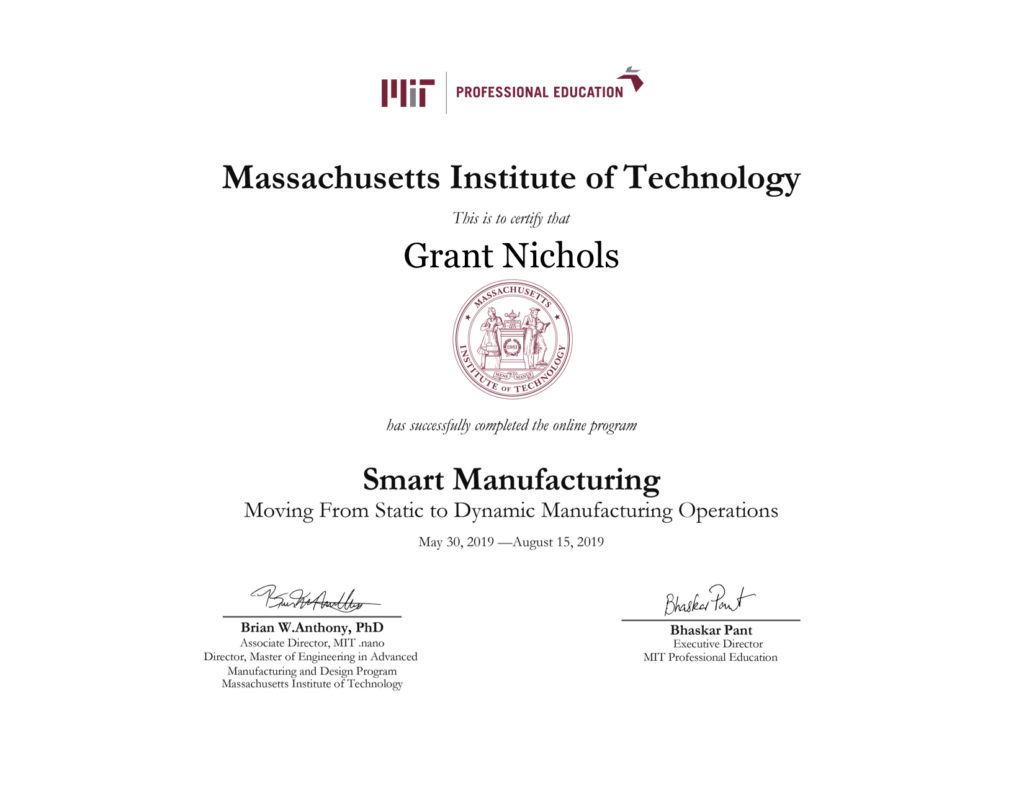How important is education as a high-level executive?
Education for Executives – Grant Nichols
Recently, I partook in an online MIT Smart Manufacturing course for 10 weeks. Over the timeframe of this course, I was able to meet great people, connect with some of the leading educators in the country, and gain deeper insights into the manufacturing industry.
The concept of the course was to learn how to shift from static to dynamic operations. What this means is collecting various types of data, taking into account those different types of data, and finding the trends comparable in datasets using visualization tools. This course was meant for experienced professionals in manufacturing that were attempting to understand and/or make a shift to more effective data analysis within their operations. But, this really helped our company’s understanding of what struggles and obstacles manufacturers have to overcome on a daily basis to move toward a more dynamic operation.
What We Did In The Class:
Each week, there was a new topic to learn about and new skills to apply to our everyday lives. The course started with being able to identify outliers and trends in datasets and moving all the way to invest in Smart Manufacturing. I was able to step inside the shoes of the manufacturers and go through the process to implement smarter and safer data systems. Being able to go through this process helped me to understand why manufacturers have such a hard time moving to smart manufacturing. There are so many outside factors, internal rearrangement, and machine capabilities a manufacturer has to deal with in order to make progress in this critical area. Though not impossible, it can be a struggle at first.
How To Combat The Struggle:
Obviously, since I operate a business intelligence organization, I continued throughout the class thinking of ways that we could make this process easier for the manufacturing industry. Instead of wasting hours on hours and struggling with building their own metrics, taking on a huge learning curve, and struggling to sift through data, why couldn’t they just jump from datasets to investing in Smart Manufacturing systems? Well, it’s actually not that easy. Even if you want to do something like that, there has to be plenty of preparation to make it right.
The answer to simplifying this process is: START SMALL and BUILD. Just like in business, you’ve got to start with something and continuously build on it until it becomes something more mature. Preparing documents, spreadsheets, and a process to get things ready for the next step will put you years ahead of competitors. You can not jump from A-Z overnight. There’s a system and a process, but it doesn’t have to be as detailed as the 10-week program I just went through.
Every Manufacturer Is Unique
One of the biggest lessons I learned while in the course was: everyone has a learning curve to overcome when working toward smarter and safer systems. Every manufacturer is unique and different; when it comes to dealing with each, they need to be handled with care and the utmost attention to detail in order to understand where they are going with this monster called analytics.
If you are interested in taking this course, I highly recommend it. You will get to meet some very experienced professionals, work with leaders in Smart Systems, and learn things that you had never considered a part of the transition into dynamic operations. Some of the things you will learn from this MIT course are: process control problems, sources of variation in manufacturing systems, using camera sensors, the application of machine vision, and analyzing closed-loop production data to name a few. I hope you take the opportunity and work toward a smarter manufacturing industry with us!
- Grant Nichols, Co-Founder & CEO

